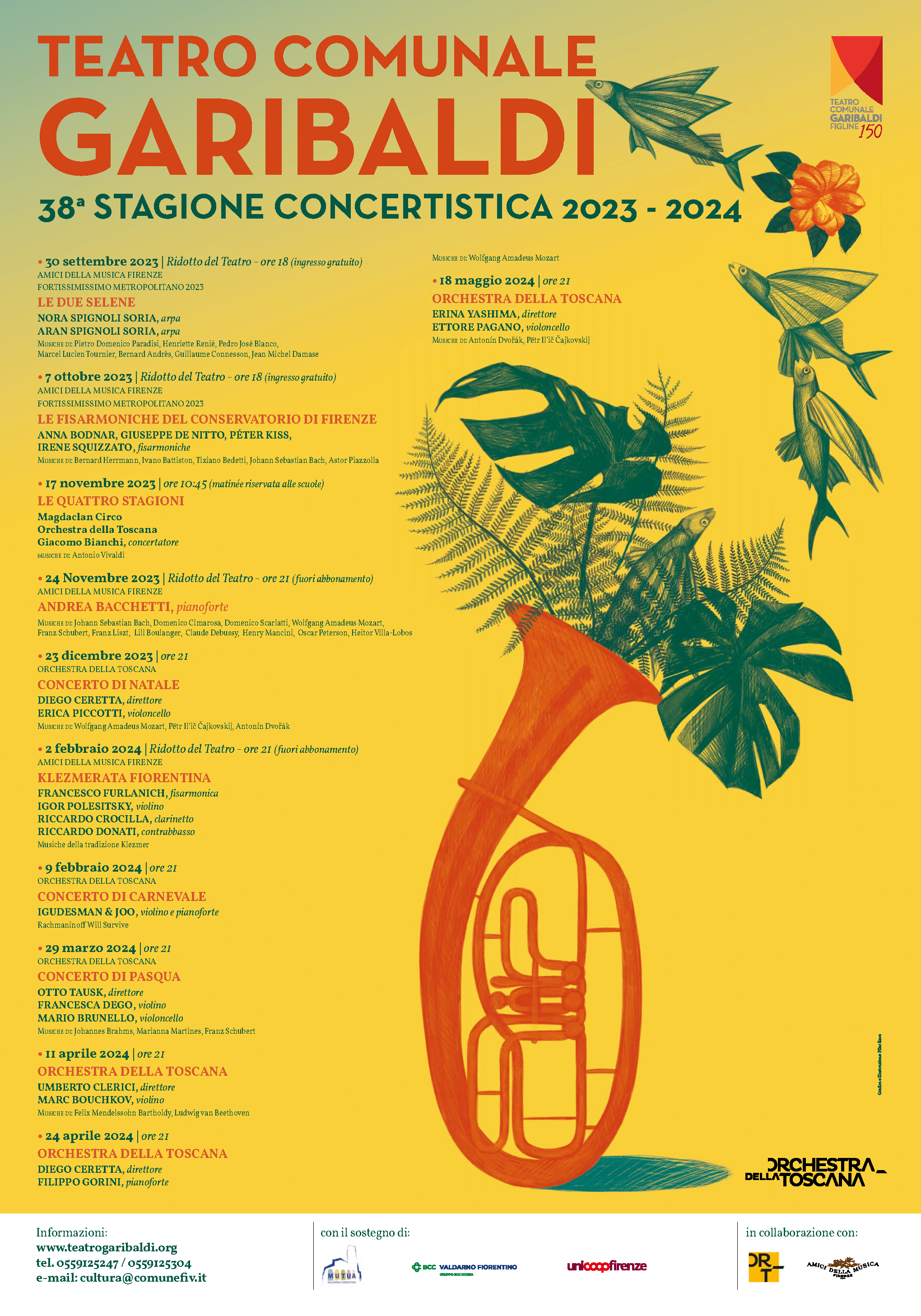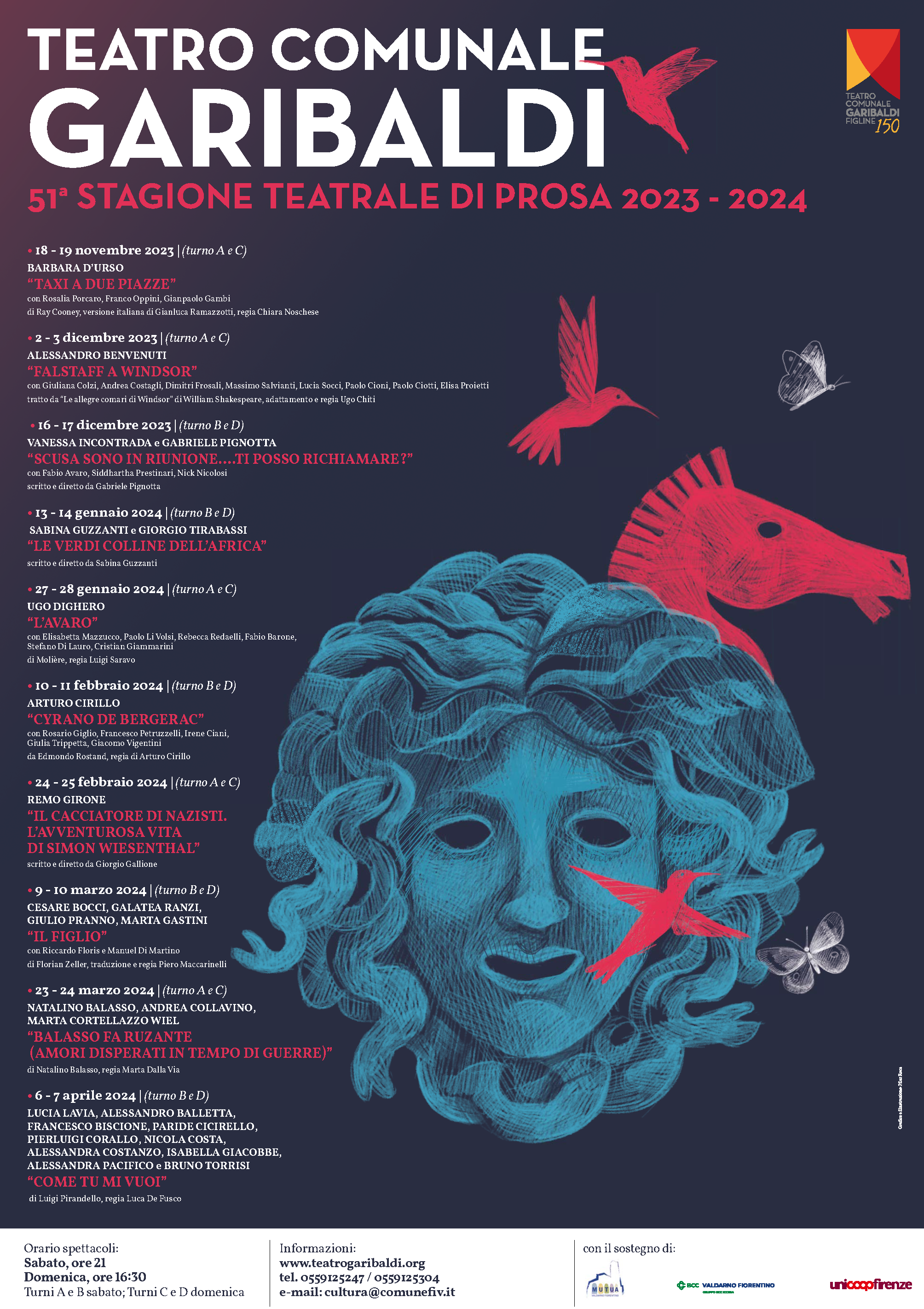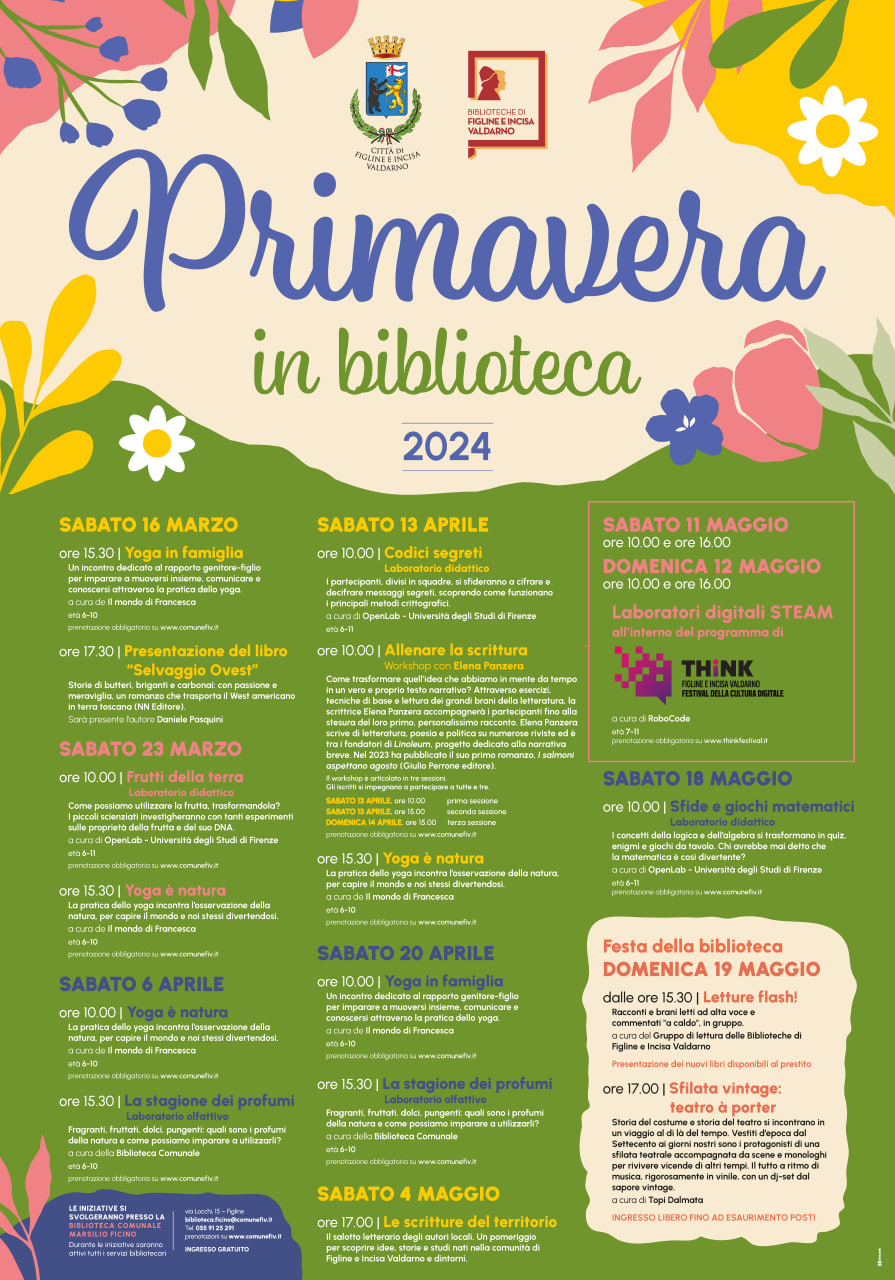Praetorian Palace
History
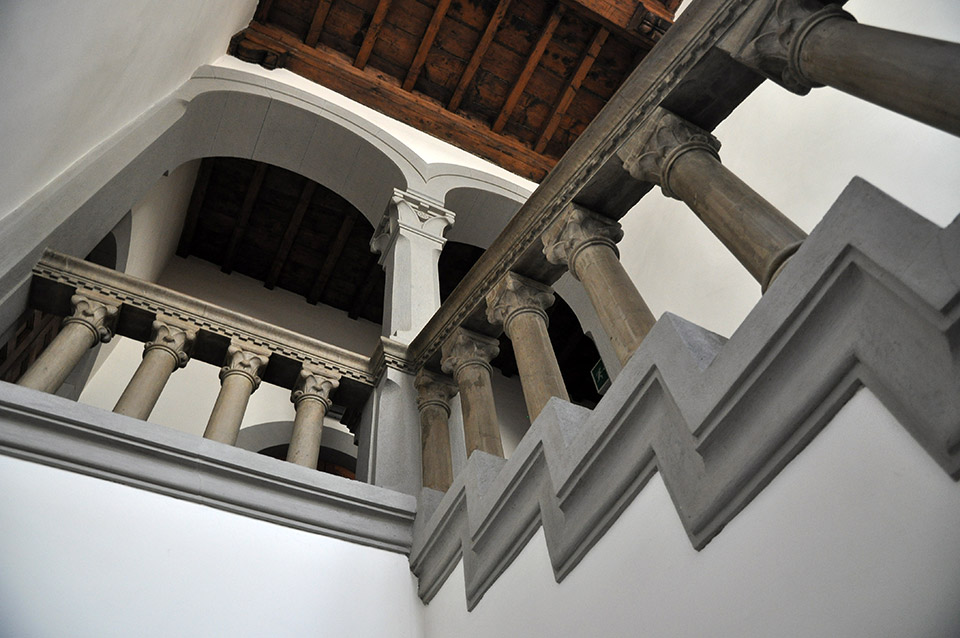
The History of the Palace
Documented since April 1293, the Palazzo podesteriale has been remodelled several times over the centuries. Transformed into a prison at the end of the 19th century, after it had assumed the name of Pretorio in the mid 18th century, it owes its current appearance to the restoration project that architect Ezio Cerpi drew up in January 1926.
The interior houses an oil on canvas depicting "Alessando de'Medici attempting to kidnap a nun" painted by Figline painter Egisto Sarri between 1885 and 1895, while at the entrance is the bell, detached from the palace tower, which was cast in 1384 by the Commune of Florence for the castle of Susinana in the upper Senio valley and assigned to the Commune of Figline in June 1387 by the Florentine Signoria.
In the chapel dedicated to the fallen of the Great War, a glazed terracotta altarpiece from 1515-1520 attributed to Benedetto Buglioni has been housed since 1931.
After its reopening in February 2003, following restoration work, it became the seat of the pre-unification municipal archive with documents from 1365 to 1865 and other archival fonds ranging from 1364 to 1985.
In 2011, a palio painted by Lorenzo Bonechi, an esteemed painter from Figlino who died in 1994, was placed at the entrance of the palace.
The bell of the tower of the palazzo del Podestà, now the Pretorio, was cast in 1384 by a Florentine master bellringer, to be installed in the Apennine castle of Susinana (Palazzuolo sul Senio).
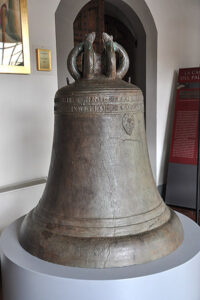 Until a few years earlier, this location was also the centre of the Lordship of the Pagani-Ubaldini then became the seat of a garrison, following its conquest by the Municipality of Florence. In February 1387the garrison ended up being destroyed during a revolt by the local population. Before the castle finally disappeared, however, all weapons, tools and removable structures found within the fortification were moved elsewhere. These included the bell, which had been installed three years earlier inside the castle and was moved to Palazzuolo sul Senioseat of the vicariate.
Until a few years earlier, this location was also the centre of the Lordship of the Pagani-Ubaldini then became the seat of a garrison, following its conquest by the Municipality of Florence. In February 1387the garrison ended up being destroyed during a revolt by the local population. Before the castle finally disappeared, however, all weapons, tools and removable structures found within the fortification were moved elsewhere. These included the bell, which had been installed three years earlier inside the castle and was moved to Palazzuolo sul Senioseat of the vicariate.
On11 June of that same year, the feast of St Barnabas and the anniversary of the Guelph victory at Campaldino, the bell was attributed to representatives of the Figlino community by Florentine decision. The accompanying letter that Florence had sent to the vicar of Palazzuolo sul Senio to authorise its transfer to its Valdarno seat contained the hope that the bell would serve as a warning and deterrent against the Ghibellines. In fact, since the previous century, the town and its population had never given much proof of loyalty to the Florentine Republic: in 1366, there had even been the murder of one of the leading representatives of the Guelph party in Figlino, without the possibility of finding and punishing the perpetrators.
However, the political motive was also very evident because, the following year, the community promoted the drafting of a statute that, provocatively, was not sent to Florence for approval: a move intended to underline the autonomy of Figlino. But this lack of political reliability created perplexity in the political ruling class. The decision, taken a short time earlier, to wall the town and its market place now risked turning Figline into a potential centre of resistance by the local population and some members of its elite, which was politically uncontrollable. Florence responded to these provocations by building a stable and fortified residence for one of its garrisons, the cassero (today' s Garibaldi Municipal Theatre). Moreover, in an attempt to populate the town with families of the Guelph faith, the alleged Ghibellines were expelled from the town.
In November 1379, Figline underwent a risky assault attempt by a group of armed men, who were in danger of being joined by some of the city's bandits: the Ciompi. On that occasion, the population proved their loyalty to Florence, preventing the conquest and occupation of the town and forcing the attackers to retreat. In this regard, the chronicler Marchionne di Coppo Stefani wrote that, thanks to the alarm given, no enemy could have been saved 'if only a bell had shouted after them'.
Indeed, in 1387, the bell left the Senio valley and moved to Figline with the declared intention of acting as a deterrent to any possible attempts at anti-Florentine revolt. But perhaps, by then, there was hardly any need to 'curb - as an official document had stated only a few years earlier - the pride of the many Ghibellines residing within the town'.
The chimes of the bell had become part of the world of all those who would hear them around and within the walls of the Land of Figline.
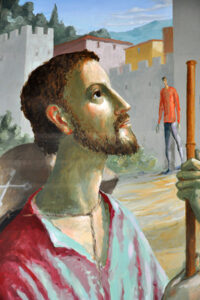 At the entrance of Praetorian Palace is located the Palio painted by Lorenzo Bonechi, estimated figlinese painter who died prematurely in 1994. It was in September of that year that the then mayor, Mauro Fariniasked the artist to paint the 'rag"the banner that in that edition of the Palio di San Rocco would have gone to Porta Fiorentina.
At the entrance of Praetorian Palace is located the Palio painted by Lorenzo Bonechi, estimated figlinese painter who died prematurely in 1994. It was in September of that year that the then mayor, Mauro Fariniasked the artist to paint the 'rag"the banner that in that edition of the Palio di San Rocco would have gone to Porta Fiorentina.
Lorenzo Bonechi died on 23 November of the same year and that 'rag' remains one of the last works that the artist gave to his municipality as a sign of participation and closeness. The cloth depicts a pilgrim, Saint Roch, who seems to be returning from his journey along the roads of the world and of life, to the walls of his city, among its people.
This painting, generously donated by those who won it back then, will therefore return to public view in the Palazzo Pretorio. The ceremony will be attended by the mayor Riccardo Nocentini, the councillor for Culture, Patrizia Campanelli, the cultural association KALEIDOS, organiser of the event, and representatives of Porta Fiorentina, as well as the art historian Mauro Pratesi, who will illustrate the painting.
'Contemporary art, true contemporary art, is art that manages to be true, to represent truth'.
- Lorenzo Bonechi
Lorenzo Bonechi, 1955-1994
Biography taken from: M. Bucci, C. Marco, 'Lorenzo Bonechi. Sculptures and Landscapes" 2009
The Tuscan painter and sculptor Lorenzo Bonechi was born in Figline Valdarno on 12 April 1955.The artist made his debut in 1982 by exhibiting in several group shows inspired by the research of 'Pittura Colta' in Prato, Rome, London and Bologna.
Around the 1980s, his interest in sculpture was born, which became part of his artistic activity, previously oriented towards drawing, graphics and tempera paintings.
During his career, Bonechi produced elaborate models in clay and other materials as models for paintings.
He has always been attached to his homeland, the Valdarno, where he received his first artistic education by studying 14th and 15th century Tuscan painting, especially from Siena.
His painting is colourful, full and dazzling in colour.
Since 1984 Lorenzo Bonechi has taken part in numerous national and international group exhibitions including: Rice of the Universe; A new Romanticism. Sixteen Artists from Italy in Washington D.C. and Akron, Ohio; New Prints and Drawings at the Tate Gallery in London and Metaphor and/or Symbol; A Perspective on Contemporary Art at the National Museum of Modern Art in Tokyo and the National Museum of Art in Osaka.
His first solo exhibition was in 1985 at the Galleria Carini in Florence, which was later also shown at the Fabian Carlsson Gallery in London and the Sharpe Gallery in New York.
1987 saw the creation of the Città Celesti (Celestial Cities) pictorial cycle, linear, essential constructions inspired by the Heavenly Jerusalem, formally close to geometric abstraction, due to its search for harmony between lines, colours and surfaces.
In 1995, the painter was invited to the 46th International Art Biennale in Venice, but unfortunately he died suddenly on 23 November 1994, aged 39, of an aortic aneurysm.
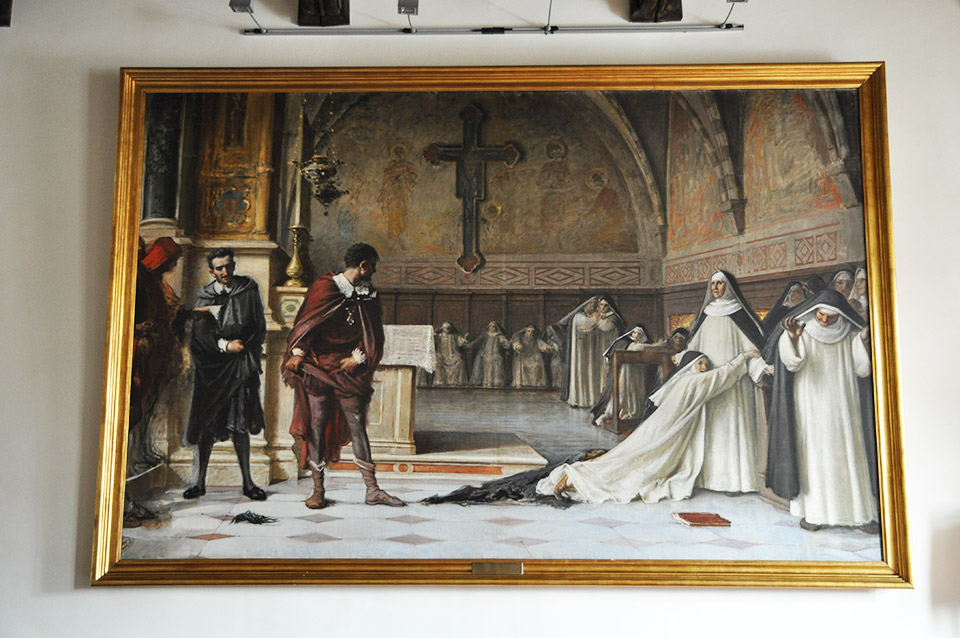
The painting depicts Alessandro De' Medici attempting to kidnap a nun.
It is an unfinished painting by the Figline painter Egisto Sarri(1895) and donated by his son Corrado to the municipality of Figline.
The municipal council then unanimously decided to publicly exhibit him in the room on the first floor of Palazzo Pretorio, dedicated to him, in order to keep his memory alive.


